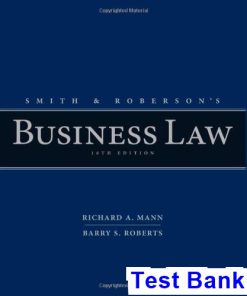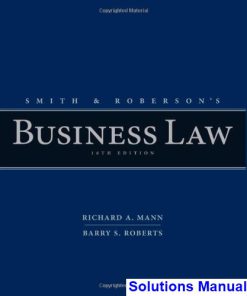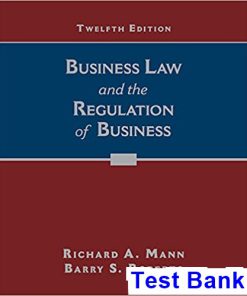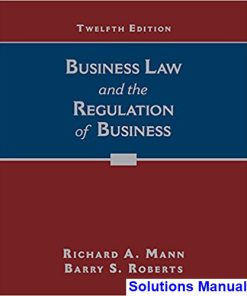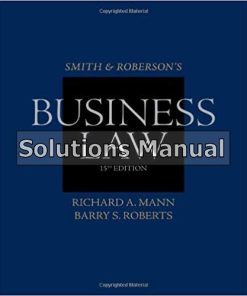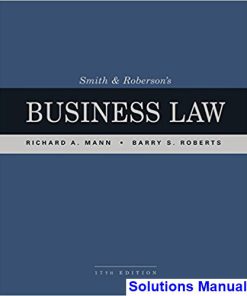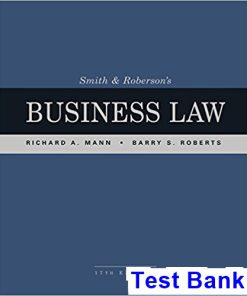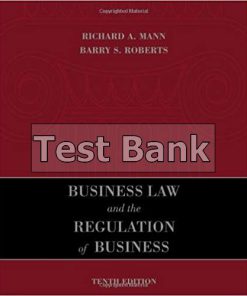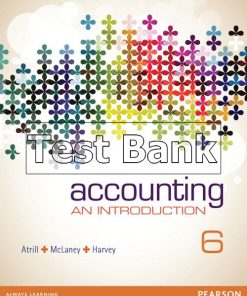Smith And Robersons Business Law 15th Edition Mann Test Bank
$50.00 Original price was: $50.00.$26.99Current price is: $26.99.
Smith And Robersons Business Law 15th Edition Mann Test Bank.
This is completed downloadable of Smith And Robersons Business Law 15th Edition Mann Test Bank
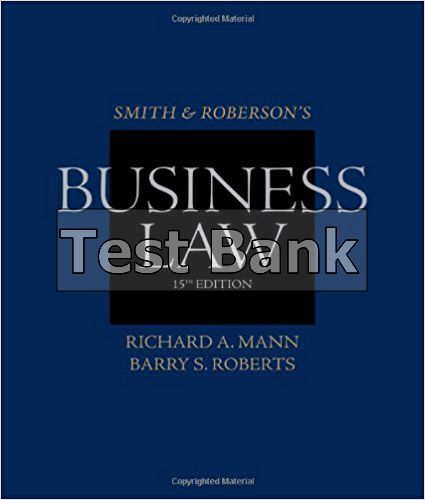
Product Details:
- ISBN-10 : 0538473630
- ISBN-13 : 978-0538473637
- Author: Richard A. Mann (Author), Barry S. Roberts (Author)
Continuing a long tradition of accuracy and up-to-date coverage, the Fifteenth Edition of SMITH AND ROBERSON’S BUSINESS LAW is the most complete and credible business law book available. This updated classic delivers a comprehensive, detailed presentation of business law issues ranging from traditional topics to the latest laws and emerging trends. The cases – located at the end of each chapter – offer an excellent mix of landmark and current decisions and are edited to preserve much of the language of the court, allowing you to see how the law applies to real business practice. Proven, comprehensive, and completely up-to-date, this trusted book will give you a solid understanding of modern business law and its impact on the way you–and your employers, competitors, and colleagues–practice business.
Table of Content:
Chapter 1:
Law serves large number of functions and purposes in the society. Law is a guidepost for accepting the behavior of the society. Law has some systematic orders and activities related to social pressure, backed by force in such society. Law is abstract and lengthy. Law also has some terms with rules and regulations that guide the actions and relations among the persons, companies and organizations.
The four main functions of law are as shown below:
• Establish the standards-
Law means the guidepost for the minimum accepted behavior in the society. Some persons do crime activities which is not tolerable by the society as these activities are injuring or damaging the persons or their things.
• Maintaining order-
It is the main offshoot to establishing the standards in law. It is important to maintain the records in the civil society because it shows the law. The law is enforced in nature and it provides the records which is consistent with the guidelines of public.
• Resolving the Disputes-
Conflicts are not voidable in the public, as it is made of people and all people have different needs, wants, values and views. It also gives some formal reasons to solve the disputes of court system. It also has the federal court system and every state have a different court system.
• Protecting Liberties and Rights-
The citizens of the United States have many liberties and rights related to the constitutions and statutes. The main goal of the law is to save the liberties and rights of the peoples, organizations from violations.
Chapter 2:
Dr. W should reduce the ABC Drug Company’s workforce by 15 percent by taking the following steps:
Step 1 : Identify the most important ethical issues arising from the situation and prioritize it.
The most important ethical issues are given below:
1. Is it ethical to lay off more non-minority than minorities in order to retain the recent gains in minority hiring, even if employees with more seniority and/or higher performances are to lay off?
2. Is it ethical to layoff employees based on seniority even if that would require laying off minorities in conflict with ABC Drug Company’s affirmative action policy?
Because the two issues are inter-related to the question how Dr. W should carry out his instructions, both should be equally prioritized.
Step 2: Identify Dr. W’s options and the ethical implications of the options.
Option 1: layoff the 15% of employees with the least amount of seniority regardless of minority status.
• Option 1 presents the difficult issue of laying off more minority employees who were recently hired than nonminority employees. This decision would violate the company’s affirmative action policy of advancing minority employment even in layoffs. Thus, under social fundamentalism, this option is not viable.
• However, Option 1 is viable under ethical relativism if Dr. W feels that it is fair to retain the employees who have been with the company the longest. Similarly, under Deontology, laying off a large number of minorities would be ethical as long as the company’s motives are purely to retain senior employees with regard to minority statuses.
• Distributive justice would consider Option 1 as unfair because it does not provide equal opportunities to all groups of people. Likewise, this option would dismiss minorities and the community, which would be inconsistent with the stakeholder model where the company is responsible for the community at large.
Option 2: Layoff 15% of the nonminority employees.
• Under Social Fundamentalism, Option 2 is consistent with the company’s affirmative action policy and is therefore viable. Likewise, Dr. W is very concerned with maintaining the minority gains; therefore, Dr. W would feel like Option 2 is the best route. Under Ethical Relativism, he should be justified in choosing this option.
• Option 2 would also be favored under distributive justice because it would provide equality of opportunity for minorities regardless of its effects on the company. It would take the community into account, which is important for the stakeholder model. However, the nonminority employees would suffer, which conflicts with libertarian viewpoints of opposing interference by society.
• Finally, if Dr. W’s only motives are to protect the company and its appearance by retaining minorities even if it means laying off long-term, high-performing employees, then the nonminority employees may argue that this option is unethical from a deontology standpoint.
Option 3: layoff the 15% of employees with the lowest performance ratings regardless of minority or seniority status.
This is a performance-based layoff process which may effectively nullify minority versus seniority concerns. It could result in an arbitrary process with results that are unsatisfactory to the company, its employees, and the society.
Step 3: Choose the best option and explain your choice.
Option 3 is the best way to layoff the 15% of workforce as it is unbiased.
Step 4.Develop a strategy for implementing your resolution.
Inform the managers and directors about the decision. Remind them of their responsibility for implementing the equal employment opportunity and affirmative action policy. Request that they bring their suggestions and discuss their selections with prior to the layoffs to ensure consistent and accurate enforcement of your decision. A statement to the employees explaining the reason and selection process for the layoffs should be issued.
People Also Search:
smith and robersons business law mann
smith and robersons business law 15th edition mann
smith and robersons business law
smith and robersons business law 15th edition
smith and robersons business law 15th edition testbank download pdf
smith and robersons business law 15th edition download scribd
Instant download after Payment is complete
You may also like…
Solutions Manual
Smith And Robersons Business Law 15th Edition Mann Solutions Manual
Related products
Test Bank





